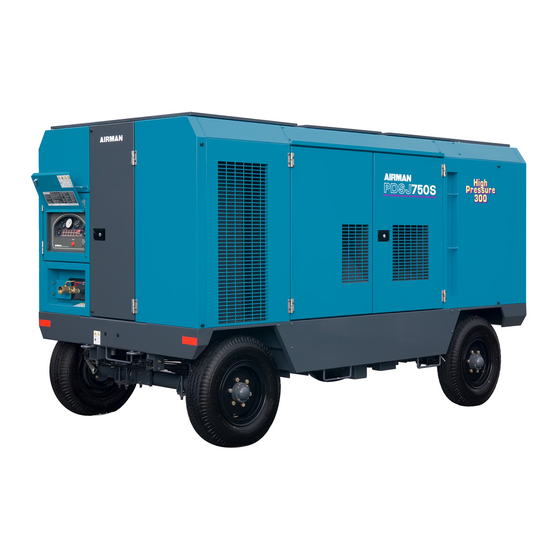
Table of Contents
Advertisement
Advertisement
Table of Contents

Summarization of Contents
Safety
Caution before Operation
Guidelines and warnings for safe operation prior to starting the machine.
Handling battery
Safety precautions for handling batteries, including explosion and chemical burn risks.
Cautions of hose attachment and removal
Warnings regarding proper hose connection and removal to prevent injury from high-pressure air.
Safety outfit
Recommendations against wearing loose clothing or jewelry that could be caught in machinery.
Maintain both physicl and mental health
Advisories to operate the machine only when alert and not under the influence of substances.
Protection equipments
Mandatory use of personal protective equipment such as helmets, glasses, and gloves.
Safety fittings
Importance of having first-aid boxes and fire extinguishers readily available.
Safety around the machine
Ensuring the work area is clear of obstructions and establishing safety enclosures.
Caution during Operation
Critical warnings to avoid during the operation of the compressor unit.
Do not replenish compressor oil during operation
Warning against opening the oil filler cap while the machine is running or immediately after.
Draining during operation prohibited
Prohibition of opening drain valves for receiver tank, coolant, or engine oil during operation.
Never direct the compressed air to people and foods
Warning against using compressed air for personal use or on food due to injury risk.
Hands off from rotating parts and belts
Caution to keep hands clear of moving parts and belts to prevent serious injury.
Do not remove radiator cap during operation
Warning against removing the radiator cap during operation to prevent scalding.
Operation with compressed air supply port opened is prohibited
Prohibition of operating the machine with open air supply ports unless connected.
Do not touch hot parts
Warning against touching hot components like engine, exhaust, and pipes during operation.
Fire prevention
Precautions against fire, including avoiding open flames near fuel and keeping the area clear.
Caution during Inspection and Maintenance
Essential safety measures to follow before, during, and after inspection and maintenance.
Hang a “Now Checking and under Maintenance” tag
Procedure to secure the machine by removing the key and attaching a maintenance tag.
Refilling of compressor oil
Safety steps for refilling compressor oil, ensuring no residual pressure before opening cap.
Be careful of high-pressurized air blowout
Warning about residual pressure in air piping and the need to release it before maintenance.
Draining separator receiver tank
Procedure for safely draining the separator receiver tank, ensuring zero residual pressure.
Adjusting tension of fan belt
Procedure for adjusting fan belt tension, emphasizing engine shutdown and key removal.
Hands off from cooling fan
Warning to stop the engine and remove the key before working near the cooling fan.
Cleaning by air-blow
Safety advice to wear eye protection when cleaning with compressed air.
Lighting apparatus
Recommendation to use lamps with safety guards in dark areas to prevent accidents.
Opening coolant water drain valve cap
Caution to allow coolant to cool down before draining to prevent scalding.
Refilling or draining of engine oil
Procedure for checking, refilling, or draining engine oil after allowing it to cool.
Fear of fire
Importance of periodical checks of oil and separator to prevent overheating and fire.
Disposal of waste liquid, etc.
Guidelines for environmentally safe disposal of waste liquids like oil, fuel, and coolant.
Safety Warning Labels
Information on safety labels attached to the machine and the importance of keeping them clean.
Part Names
Internal Components and Part Names
Identification and functional description of the compressor's internal parts.
Installation
Transportation
Procedures for safe loading, unloading, and securing the unit for transport.
Handling the Drawbar
Precautions and steps for securing and releasing the drawbar during transportation.
Towing the Unit
Safety guidelines for towing the unit, including speed limits and vehicle compatibility.
Installation
Guidelines for placing the machine in a suitable environment and parking precautions.
Compressed Air Service Valve
Cautionary advice on installing a check valve for the compressed air outlet for safety.
Operation
Features of this unit
Information on selectable pressure settings and operational capabilities of the unit.
Instrument Panel
Overview of gauges, indicator lamps, and controls on the compressor's instrument panel.
Door
Instructions for safely opening and closing the unit's access door.
Lubricating oil · Coolant · Fuel
Recommendations for engine oil, compressor oil, coolant, and fuel types and properties.
Check before Starting Unit
Essential pre-operation checks, including engine oil and coolant levels.
Unit Operation
Key precautions and procedures for operating the compressor unit safely.
Procedure to Start the Unit
Step-by-step guide for starting the compressor, including warm-up and initial operation.
Operating Procedures when Engine Fails to Start up on First Attempt
Troubleshooting steps if the engine fails to start, covering fuel and battery issues.
How to Start the Unit at Low Temperature
Specific procedures for starting the compressor in cold weather conditions below -5°C.
Gauge Indication while Operating
Interpreting gauge readings and indicator lamps during operation for performance and alerts.
Performance Check of Safety Valve
Procedure for verifying the safety valve's functionality and set pressure.
Check Clogging in Oil Separator
Method for checking the oil separator for clogging using the differential pressure gauge.
Stopping Procedures
Steps for safely shutting down and securing the compressor unit after operation.



Need help?
Do you have a question about the PDSJ750S-4B2 and is the answer not in the manual?
Questions and answers